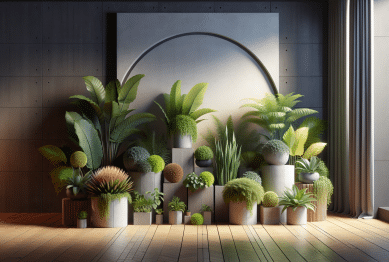Discover how vertical gardening lets you maximize even the smallest home & garden spaces. Learn practical advice and creative solutions to bring greenery, improved air quality, and beauty to balconies, patios, or interiors. Unveil the essentials for starting a thriving vertical garden no matter the size of your living area.
Why Vertical Gardening Makes Sense for Compact Homes
Vertical gardening is an innovative method that cleverly utilizes wall space, allowing for lush greenery in even the tightest corners. As urban living spaces shrink, interest in maximizing home and garden potential has soared. Through vertical gardens, individuals bring nature indoors or onto balconies, boosting mood and enhancing the quality of small living spaces. More than just a decorative trend, these gardens can also help with temperature regulation, providing a buffer against both heat and cold. It’s no wonder this gardening technique is in high demand among those looking to enhance compact homes without sacrificing style or practicality.
One compelling benefit of choosing vertical gardening is the ability to create a personalized oasis regardless of floor space. Those who reside in apartments or townhouses often miss the greenery of larger gardens. By leveraging vertical space, such as empty walls or unused fences, anyone can install living walls with minimal disruption. These vertical displays don’t just add greenery—they can serve as privacy screens, reduce noise, and even support kitchen herb gardens at arm’s reach. Vertical gardening caters to the functional and aesthetic needs of modern life, transforming small spaces into lush, inviting sanctuaries.
Another noteworthy aspect is the positive environmental impact. Plants cultivated vertically absorb pollutants and release oxygen, which supports improved air quality indoors and outdoors. Even small-scale vertical gardens contribute to urban biodiversity by attracting pollinators like bees and butterflies. This makes vertical gardening not just an aesthetic choice, but a responsible one—enhancing ecosystem health even in the heart of a city. For homeowners and renters alike, this approach aligns with sustainability goals and promotes overall well-being. Altogether, vertical gardening stands out as a thoughtful choice for efficient, attractive, and eco-conscious home design.
How to Plan a Vertical Garden for Your Home
Effective planning is key to creating a successful vertical garden in limited space. Begin by assessing available surfaces—think about balcony railings, fences, interior walls, or even windows with ample sunlight. Consider moisture and light levels, as they significantly affect the selection of suitable plants and structures. Some individuals prefer modular panels, while others might build DIY trellises or opt for hanging pockets. By considering the orientation, access to water, and weight-bearing potential of each spot, planning becomes a fun exercise in creativity and problem-solving for garden enthusiasts.
Plant selection is central to the garden’s long-term vitality. Not all plants thrive under the same conditions, so tailor your choices to the specific microclimate and light exposure of your chosen surfaces. For sunny walls, succulents, herbs, and flowering vines do well; for shadier areas, ferns and mosses might be more adaptable. Mixing edible plants with decorative foliage can provide beauty and utility. Native and drought-tolerant species are also worth considering to reduce maintenance and support the local ecosystem—making the garden work for your lifestyle.
The value of a well-thought-out irrigation plan cannot be overstated. Water delivery in a vertical garden can pose unique challenges, as gravity can quickly dry out upper plants while leaving the lower ones damp. Drip irrigation systems or self-watering planters are popular solutions. For those who enjoy a hands-on approach, regular misting and targeted watering can keep plant health in check. The planning phase not only ensures a beautiful outcome but also supports sustainable practices and healthy plant growth in tight metropolitan spaces.
Materials and Tools for Building Vertical Gardens
The right materials can make or break your vertical gardening experience. Durable and lightweight structures, such as wooden pallets, plastic planting pockets, or metal grids, form the backbone of many installations. Reusing and repurposing old bookshelves or shoe organizers adds a sustainable twist, while living wall panels streamline setup for those seeking a sleeker look. The choice of materials should balance the aesthetics, load-bearing ability, and exposure to elements, allowing gardeners to match their vision and budget.
A modest toolkit is all that’s necessary for most home vertical gardens. Essentials often include a measuring tape, screwdriver or drill, wall anchors, pruning shears, and gloves. For installations indoors, waterproof backing is helpful to protect surfaces from moisture. Outdoors, weather-resistant brackets and anchors can ensure that heavier structures remain secure in changing weather. Many hardware stores carry starter sets for vertical gardens, simplifying the preparation process for beginners or those with limited DIY experience.
Soil and substrate choices are just as vital as the frame. Lightweight potting mixes, coconut coir, or even hydroponic systems work well in vertical gardening, supporting root health and managing weight. For hydroponic walls, water circulation systems maintain moisture consistently, while regular soil-based walls need careful attention to avoid overwatering or compaction. In the end, the right combination of sturdy materials and user-friendly tools can turn even novice gardeners into confident vertical growers—ready to transform their home and garden environments.
Creative Plant Arrangements and Design Ideas
Designing your vertical garden offers a world of stylistic opportunities. From geometric layouts to cascading arrangements, creativity is limitless. Incorporating colorful annuals, trailing vines, and architectural plants in a radiant tapestry can be mesmerizing. Layering different species creates texture and depth, while grouping plants with similar requirements simplifies care. Whether as a focal point in a living room or an accent wall on the patio, a personalized approach brings individuality and beauty to your space.
Beyond basic beauty, vertical gardens can also serve functional purposes. Kitchen walls with edible greens save counter space and provide fresh flavors year-round. Orchids or air plants in bathrooms catch natural humidity, brightening up a space prone to moisture. Outdoor installations near seating areas can double as privacy screens, while indoor plant walls may help muffle sound. No matter the function, each vertical garden reflects its caretaker’s personality, needs, and the environment itself.
Color and theme play important roles in vertical design. Cool greens and whites evoke calm, while bold reds and yellows infuse energy. Some opt for repeating patterns or contrasting leaf shapes for added drama. Seasonal changes allow for rotating displays—think spring bulbs followed by lush summer foliage. DIYers who embrace evolving arrangements will find plenty of inspiration in garden blogs, online galleries, and horticultural societies. Each garden becomes a living, changing canvas within the home environment.
Care, Maintenance, and Troubleshooting for Vertical Gardens
Maintenance, though often simple, is crucial for vertical garden longevity. Regularly checking soil moisture ensures that neither the top nor bottom layers are neglected. Pruning helps maintain shape, remove dead leaves, and encourage healthy growth. Fertilizers suited to plant types can be added periodically, but a balanced approach keeps nutrient levels in check. With proper routines, a vertical garden can remain vibrant and productive throughout most of the year.
Pest control in dense plantings may require special attention. Because air circulation is limited, fungal problems and insect infestations can develop more quickly. Safe organic solutions—such as neem oil or insecticidal soaps—are favored to avoid chemical buildup indoors. Observing daily or weekly for early signs of trouble is an efficient strategy. Quick troubleshooting means issues do not have the chance to spread across the entire planting, sustaining garden health with less intervention.
Adaptability is a strong advantage of vertical gardening. Plants that struggle can be rotated out, while successful species may propagate into additional spaces. Experimenting with watering systems, light exposure, or container arrangements refines each gardener’s unique setup. As vertical gardening evolves, so does the satisfaction of nurturing life in unexpected places—transforming home and garden routines and proving that even the smallest space can host a flourishing ecosystem.
Environmental and Well-being Benefits of Vertical Gardens
Beyond aesthetics, vertical gardens offer tangible health and environmental benefits. They can lower ambient temperatures, especially in urban environments where concrete and glass amplify heat. The insulating layer of plants reduces energy costs for heating and cooling indoor spaces. Improved microclimates indoors contribute to more comfortable and productive living through stabilized humidity and air purification—a bonus for allergy sufferers and those focused on well-being.
Studies continue to show that gardening activities and exposure to greenery have calming effects on the brain, reducing stress and encouraging positive mood states. Vertical gardening fits seamlessly into daily life, making mindfulness and relaxation accessible in compact dwellings. In workplaces, plant walls have been linked to productivity, attentiveness, and reduced fatigue. As interest in wellness and sustainable living grows, so does the adoption of these ‘living walls’ for holistic improvement of occupant health.
Lastly, vertical gardens contribute meaningfully to biodiversity, even in densely populated cities. They offer much-needed habitats for beneficial insects, birds, and pollinators, supporting the urban ecosystem as a whole. For those seeking to make a difference—however small—the choice to garden vertically is both impactful and rewarding. Individuals not only enhance their immediate environment but also participate in a larger movement toward sustainable cities and healthier communities.
References
1. The Royal Horticultural Society. (n.d.). How to grow a vertical garden. Retrieved from https://www.rhs.org.uk/advice/profile?pid=1036
2. Environmental Protection Agency. (n.d.). Green infrastructure: Green roofs. Retrieved from https://www.epa.gov/green-infrastructure/green-roofs
3. University of Florida IFAS Extension. (2017). Vertical gardens: Growing up in Florida. Retrieved from https://edis.ifas.ufl.edu/publication/EP509
4. Better Health Channel, Victoria State Government. (n.d.). Indoor plants. Retrieved from https://www.betterhealth.vic.gov.au/health/healthyliving/indoor-plants
5. American Society of Landscape Architects. (n.d.). The benefits of green roofs and walls. Retrieved from https://www.asla.org/ContentDetail.aspx?id=31301
6. National Wildlife Federation. (n.d.). Creating a wildlife garden. Retrieved from https://www.nwf.org/Garden-for-Wildlife/Create/At-Home











 Secrets You Never Knew About Budget-Friendly Adventure Travel
Secrets You Never Knew About Budget-Friendly Adventure Travel 

